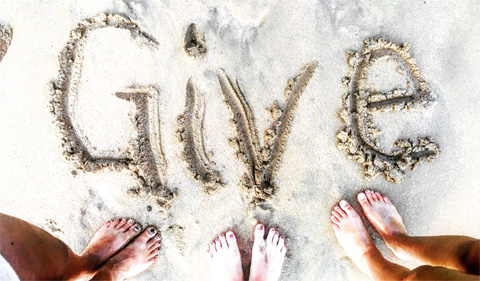
Junior Holly Richardson spent May 2016 in Nicaragua with Growth International Volunteer Excursions (GIVE)
by Kristin M. Distel
“I took a leap of faith, and it was definitely worth it,” says Environmental Biology student Holly Richardson, who spent May 2016 in Nicaragua as a member of OHIO’s branch of the Growth International Volunteer Excursions (GIVE) program.
The team with which she volunteered was composed of students from all over the world. While in Nicaragua, Richardson participated in activities ranging from reading to children to creating coral reefs.
‘Falling in Love’ with GIVE
Richardson, a junior at OHIO, says she “fell in love with GIVE” at the campus involvement fair during her freshman year. According to their website, GIVE volunteers “work on sustainable development projects that are designed to make a genuine difference by improving infrastructure, education, sanitation, water supply, and the environment.” In signing up for a volunteer project, Richardson had to choose between service projects in Nicaragua, Thailand, Laos, and Tanzania. She chose Nicaragua in part because volunteering there would allow her to scuba dive while also doing important work in the area of sustainability.
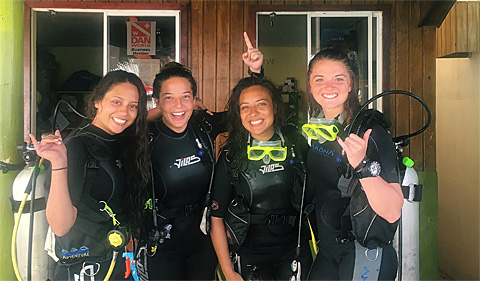
Holly Richardson (far right) and other GIVE volunteers built coral reefs, removed litter, and read to children while in Nicaragua.
Encouraging Sustainability in Nicaragua
In Jiquilillo, Richardson explains, she and the other 17 members of the group cleared out land to build new houses. Richardson notes that GIVE goes into the community and asks residents what they need, rather than making decisions as outsiders for the people of the area. The residents explained that erosion is washing away homes in Jiquilillo, so there is an urgent need to build inland.
“GIVE’s projects are all about sustainability,” Richardson says. “We didn’t use American tools. We only used tools available in Nicaragua, such as machetes, so people could continue the work after GIVE leaves. Nicaraguans know which vegetation to cut down, which to preserve, and which are good for shade.” Honoring the needs and knowledge of the native residents is essential to GIVE’s mission. “The people of Jiquilillo know what vegetation they need to keep and use.”
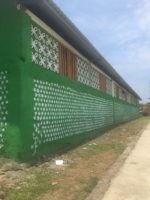
A volunteer group that visited Nicaragua prior to Richardson’s trip built a school out of over 15,000 plastic bottles. Each “star” shape visible in the photograph is the bottom of a plastic bottle.
Education Initiatives
Richardson explains that previous volunteer groups built a school building using two-liter bottles, which they packed with sand and concrete to create makeshift bricks. This particular area of Nicaragua does not have trash pickup, she explains, so most residents either burn trash or throw it in the ocean, not realizing the vast environmental consequences of doing so. The creation of the school kept over 15,000 plastic bottles from being disposed of improperly.
In addition to their work in Jiquilillo, Richardson’s group took a boat to Little Corn Island, where they participated in a variety of volunteer activities. One of the group’s primary tasks was to volunteer in a local “reading room.” Richardson explains that she worked with children of all ages who do not yet know how to read. During her time in the Little Corn Island reading room, she worked individually with children to develop their literacy skills.
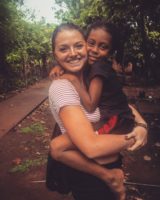
Holly Richardson with one of her reading room students
At Little Corn Island, Richardson also helped clear out trash from the polluted water in front of local restaurants. Using snorkels, GIVE students scoured the ocean for trash; they also waded through a swamp nearly two miles in length to remove litter. While cleaning the swamp, the group collected five large bags of trash, providing a significantly cleaner source of water for area residents and businesses.
‘We Were Creating a New Coral Reef System!’
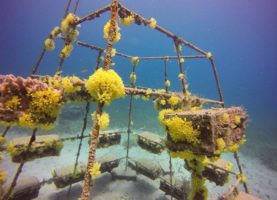
GIVE volunteers affixed dead coral to live coral. “This is what I want to do,” Richardson says.
One of the group’s most rewarding volunteer activities was the creation and restoration of coral reefs. Richardson explains that the group members took dead coral and attached to it live coral with superglue and cable ties. They attached the fused coral to a rebar structure that had been built by marine biologists who oversaw the students’ work. “It was hard, but that’s what I want to do,” Richardson explains. “It was so interesting to see whole process. We were creating a new coral reef system! We had to take measurements and write using waterproof pens. We did two dives every day.” The GIVE volunteers had some company during their dives. “Sharks came up and nestled against our legs, just like puppies!” Richardson recalls.
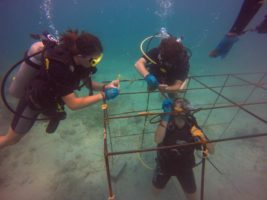
GIVE volunteers used rebar to build new coral reef systems
‘I was just so happy with life’
The most exciting portion of the trip was the group’s nighttime scuba trip, when, Richardson recalls, “Everyone was terrified at first.” Each person went into the water equipped with a flashlight and a “buddy” diver. Once each pair of divers reached the ocean floor, they turned off their flashlights. “Then we saw nothing but bioluminescence. Water kept getting in my goggles because I was tearing up; I was just so happy with life. There’s another world under the ocean. It looked just like stars.”
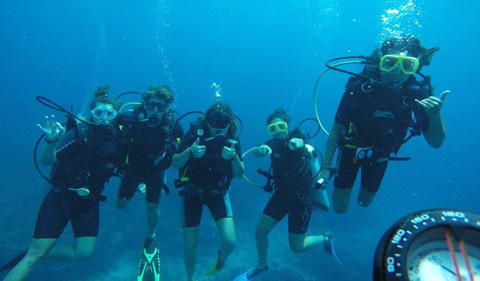
Scuba divers under water
Richardson and other volunteers scuba dive while building coral reefs
Writing about Sustainability at OHIO
Richardson has been able to apply what she learned in Nicaragua to her coursework here at OHIO, especially in Talitha May’s course, ENG 3100-J: Writing about Sustainability. “Talitha wanted us to write about what we’re passionate about. She taught me how to research what matters to me. In her class I worked on a beach erosion project, researching that and how I can help. I think that project started me on this path of beach erosion research that I’ve gotten very passionate about. The class and my trip have given me a new perspective that I’d never seen before. They focused my eye on the one subject that I want to study. I don’t like writing, but Talitha told us if that you’re passionate, it will come easily. She’s right. Writing comes naturally when you’re researching and writing about a topic that you care about. She’s the best instructor I’ve ever had.” May, in turn, commends Richardson’s passion for the subject of sustainability and notes, “Students like Holly really make OHIO top-notch!”
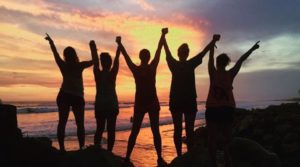
Volunteers from the GIVE group
Richardson’s volunteer work in Nicaragua has made an indelible impact on her. “Being here in the United States, we take for granted things we have. I sometimes felt like I was the only person who cared about recycling and environment, but I learned that other people care, too. Working with locals and becoming friends with them in a short amount of time is something I’ll be forever grateful for. Theresa Craig, the education coordinator in Jiquilillo, told us, if you make a friend in every country, we will have world peace. Now I know: there are people who care about the environment.”



















2 Comments